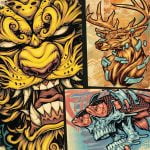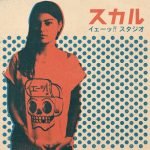Can you recall what did Facebook’s design look like on its onset, some decade and a half ago? By contemporary standards – not very flattering. So, if you happen to come across such website design today, admit it, you’d probably vamoose right away. Staying in the loop when it comes to the latest design trends is beneficial whether you’re a professional web designer, an industry rookie, or an entrepreneur who wishes its business website to ooze quality.
Besides, incorporating the latest and hottest web design trends will guarantee your website to look modern, updated, and actually taken care of – a big plus when it comes to leaving the impression of reliability in your clients’ eyes.
We have outlined the web design trends that will dominate 2020, along with some pro tips on how to successfully implement them in your design.
1. Dark mode
How could something so simple as placing light-colored text, icons, and UI elements on a dark background be so powerful? Dark mode is the web design trend that has undoubtedly dominated in 2019, and it seems unlikely that its reign will end in 2020.
Dark mode swept the online world off its feet flat-out, with top apps and websites such as Facebook Messenger, YouTube, Instagram, Viber, WhatsApp, and Chrome, as well as the latest releases of Android and Apple operating systems, turning the lights off one after another.
The color-scheme’s popularity lies in its multiple benefits, from offering users a more elegant and sleek working environment, to positively affecting the device’s battery life and energy consumption. Meanwhile, the so-called night mode is also favorable because it reduces the use of light pixels, which in turn lowers the overall brightness of a screen, causing less eyestrain, and easing reading.
Tip: To create a visually stunning website, mix dark mode with minimalistic, white elements and clean graphics and typography. For more aesthetically appealing vibe, add some vibrant, accent color schemes, glowing neon typography or futuristic elements.
2. Minimalism
A blast from the past, minimalism is a classic web design trend bound to stay. While forms and features of minimalism have changed over the years, its essentials stay the same – winning over the hearts of both designers and end-users through elegance, usability, and simplicity.
Minimalism in web design can mean a plethora of things – from minimalistic graphic elements, and narrow color palettes, to a bare minimum of text and website navigation.
The trend rose to prominence as a way of accommodating ebbing screen sizes and attention spans. Usability and navigating throughout the website are alleviated thanks to the extremely minimalist menu that take away much of the difficulty, shifting visitors’ focus from how to find certain information on engaging in information itself.
A good way of achieving minimalism in web design is ditching a heavy paragraph for a high-quality image or a video that would convey the message of the text in a more enticing and straightforward manner.
Tip: Minimalism and functionality come arm in arm, so when designing website navigation, avoid cramming up unrelated information into one section. Make it easy for your visitors to find services you offer, contact page, or FAQ while keeping it light.
3. Black & white
2020 will be the year of minimalism, even in website color schemes. Black and white, paired with a very narrow spectrum of grayscale are everlastingly elegant, aesthetic and modern.
To avoid your website getting dull, add some high-quality black and white photographs or artistic illustrations.
Tip: 50 shades of gray might be a literary bestseller, but in website design, it’s a flop. If you opt for a black and white website with grayscale-colored elements, stick to two to three shades of gray.
4. Luminous color schemes
On the complete opposite, luminous color schemes will be a step forward in isometric trend in web design. Glowing, neon colors such as blues, purples, and pinks will make your website look modern and futuristic. Coupled with deeper and darker shades, these luminous colors will pop out from screens, forging a bold and daring appearance of your site.
Tip: Neon-colored elements go well with any of the above-mentioned web design trends (dark mode, minimalism, black and white), as darker, non-colorful background makes these luminous colors stand out even more.
5. Hand-drawn elements
Human-centered approach in design has seen something of a renaissance lately, and no better example of that than hand-drawn elements. Whether it’s cartoonish illustrations, drawn icons, or handwritten lettering, technology in recent years is all about bringing emotions, humanity, and personal touch.
Moreover, hand-drawn graphics radiate positivity, soulfulness, and easy-going, so this trend is a definite must for 2020 if you aim to show your clients just how creative and imaginative you can be.
Tip: Artistic illustrations will add a dose of authentic and unforced to your website, yet be careful – not all professions will benefit from an illustrated website. To ensure your web presentation look childish, thoughtless, or flippant, and consequently drive off both existing and potential clients, seek advice from a professional in the web design field.
6. Bold typography
Over the last years, providing a pleasurable user experience has been the main aim of web designers. One of the most important aspects of a good UX is clean, legible typography. Bold, all-caps fonts, monochromatically colored or transparent with an outline are the hottest trend today.
Cursive fonts are hard-to-read and it’s very easy to mix similar-looking letters, so such typography has nothing to do on a fresh, modern website that aims for good UX.
Tip: Large typography is great for captivating your visitors’ attention, but make sure the letters are properly sized on all devices, from desktops to smartphones. One letter taking up the entire smartphone screen is a bad, bad user experience.
7. 3D elements
Probably one of the most enticing web design trends is entering on big doors thanks to massive technological advancements in recent years. 3D elements are fun, engaging, and tend to keep visitors longer on the website.
Depth adds to the sense of realism, a quality that can be especially beneficial for e-commerce, where 3D imagery can be utilized in presenting products from various perspectives or in practical use.
Tip: 3D elements can be quite heavy to load, so don’t get overexcited while adding them to your website. Moderately employed, they can do wonders; excessively, they can sink your website’s SEO efforts.
8. Shadows, layers, and floating elements
Tone down the boastfulness of 3D by using shadows, layers, and floating elements. It’s a step up from the material design trend which can convert a simple image into a dazzling feature. This pseudo-3D effect can be done on icons, graphics, and text as well.
Another down-to-earth trend that can create the illusion of depth is overlapping layers. Layering multiple elements such as text, images, videos, icons, etc. can turn an overcrowded and busy website into a web presentation with a thought-through arrangement and undisturbed flow.
Tip: The good ol’ ‘less is more’ definitely applies here. If your website starts to resemble a PowerPoint presentation with all the available effects like fading, (dis)appearing, resizing, dropping shadows, etc. – abort the mission.
9. User-triggered animation
Until lately, website animations largely took place on their own, independently from the visitors’ actions on the site itself. 2020 is about to change that, with the advent of user-triggered animation.
The above-mentioned trends of either 3D or floating or layered elements, are possible to incorporate into user-triggered animation. Clicking, hovering, and other visitors’ actions can bring about alterations of color, size, design, etc. These animations are useful when you want your website to be more captivating and stimulating, yet keep its simplicity and elegance.
Tip: Don’t go overboard – one or two user-triggered animations are quite enough. A larger number of animations can cause users’ every mouse move to do something on the website, thus creating confusion and dissatisfaction.
10. Gradient
Gradients are back in fashion, stronger than ever. 2020 will witness bold, multi-colored gradients on everything from backgrounds to text fill-ins. Combining multiple colors that create contrast and the illusion of depth is the winning combo for a sleek, cutting-edge website look.
Tip: Avoid going for monotone gradients as they look sloppy, boring, and unstylish.
11. Hero videos or text-only
“A picture is worth a thousand words”. True for 2019, but thanks to high-speed Internet connections, static hero images are gone. Instead, high-quality videos that create a movie-like experience are an excellent way of greeting, engaging and entertaining visitors in 2020. Imagery is crucial in visual design because it enables delivering the message quickly and straightforwardly, and no better way of showing that than using a video.
Au contraire, there are text-only heroes. Big, fat, bold typography, with no photography and videos, styled in monochromatic color scheme is the new hot trend for 2020. Stripping down the part of the website that visitors will see first is a courageous experiment, but the trend that will definitely witness its peak in the ongoing year.
Tip: Videos take time to load, so if your choice for the hero section falls on one, make sure it’s properly sized and doesn’t lag your website loading time. Placing a YouTube video in the hero is a big no – either integrate it into your website or avoid video completely.
To sum up
2020 will be the year of diversity when it comes to trends dominating the web design world. From absolute simplicity to over-the-top color and elements combinations, designers will have an array of choices on how to create a website that will stand out among all the other attention-grabbing designs out there.
Designers who aim for the best UX and eye-catching website looks should have in mind incorporating some of the web design trends that will dominate in 2020:
- Dark mode
- Minimalism
- Black & white
- Luminous color schemes
- Hand-drawn elements
- Bold typography
- 3D elements
- Shadows, layers, and floating elements
- User-triggered animation
- Multi-colored gradients
- Videos or text-only heroes
This year already looks promising, for both designers who will have their hands full with fusing these trends together, but also web design muggles who will get the chance of witnessing and enjoying them all around the Web.





